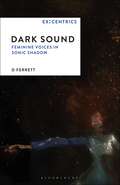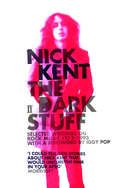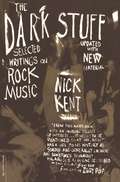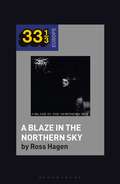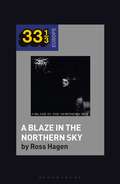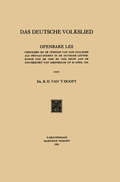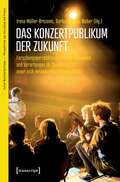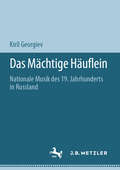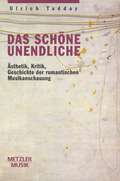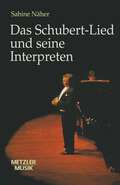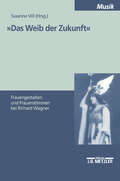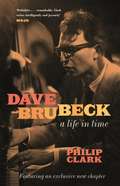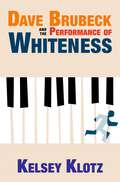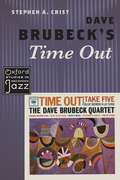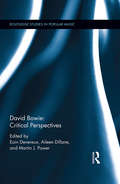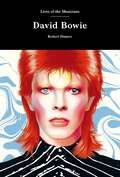- Table View
- List View
Dark Sound: Feminine Voices in Sonic Shadow (Ex:Centrics #1)
by D FerrettDark sound carries the dense cultural weight of darkness; it is the undertow of music that embodies melancholy, desire, grief, violence, rage, pain, loss and longing. Compelling and unnerving, dark sound immerses bodies in the darkest moments and delves into the depths of our hidden inner selves. There is a strangely perverse appeal about music that conjures intense affective states and about sound that can move its listeners to the very edge of the sayable. Through a series of case studies that include Moor Mother, Anna Calvi, Björk, Chelsea Wolfe and Diamanda Galás, D Ferrett argues that the extreme limits and transgressions of dark sound not only imply the limits of language, but are moreover tied to a cultural and historical association between darkness and the feminine within music and music discourse. Whilst the oppressive and violent associations between darkness and femininity are acknowledged, the author challenges their value to misogynistic, racist, capitalist and patriarchal power, showing how dark sound is charged with social, creative and political momentum.
The Dark Stuff: Selected Writings On Rock Music Updated Edition (Faber Greatest Hits Ser.)
by Nick KentIn The Dark Stuff Nick Kent profiles twenty-two of the most gifted and self-destructive talents in rock history. From Brian Wilson to Syd Barrett, the Rolling Stones to Neil Young, Iggy Pop to Lou Reed, he offers intimate portraits that are unimaginable in the world of today's market driven music business.
The Dark Stuff: Selected Writings On Rock Music Updated Edition
by Nick Kent Iggy PopA smart, scathing look at the most hell-bent performers of our time: Here are profiles of everyone you'd expect (and a few you wouldn't)-Brian Wilson, Miles Davis, Jerry Lee Lewis, Roy Orbison, Sid Vicious, and Kurt Cobain. "Kent matters because he wrote about rock better than anyone before or since." -Tony Parsons, The Daily Telegraph
Darkthrone’s A Blaze in the Northern Sky (33 1/3 Europe)
by Ross HagenDarkthrone's A Blaze in the Northern Sky (1992) is a foundational keystone of the musical and aesthetic vision of the notorious Norwegian black metal scene and one of the most beloved albums of the genre. Its mysterious artwork and raw sound continue to captivate and inspire black metal fans and musicians worldwide. This book explores the album in the context of exoticism and musical geography, examining how black metal music has come to conjure images of untamed Nordic wildernesses for fans worldwide. In doing so, it analyzes aspects of musical style and production that created the distinctly "grim" sound of Darkthrone and Norwegian black metal.
Darkthrone’s A Blaze in the Northern Sky (33 1/3 Europe)
by Ross HagenDarkthrone's A Blaze in the Northern Sky (1992) is a foundational keystone of the musical and aesthetic vision of the notorious Norwegian black metal scene and one of the most beloved albums of the genre. Its mysterious artwork and raw sound continue to captivate and inspire black metal fans and musicians worldwide. This book explores the album in the context of exoticism and musical geography, examining how black metal music has come to conjure images of untamed Nordic wildernesses for fans worldwide. In doing so, it analyzes aspects of musical style and production that created the distinctly "grim" sound of Darkthrone and Norwegian black metal.
Das auditive Netz: Künstlerische Forschung im medialen Dazwischen (Musik und Klangkultur #69)
by Hans-Ulrich WernerWas macht künstlerisches Forschen im Bereich Sound und Musik aus? Im Ausklang einer langen und produktiven technisch-künstlerischen sowie wissenschaftlichen Laufbahn stellt Hans-Ulrich Werner seine Ergebnisse zum Thema vor. Dazu orientiert er sich vor allem an den Ideen und Erkenntnissen der Menschen, denen er bei seinem Schaffen begegnete und die er als Akteure eines internationalen Netzes beschreibt. Somit ergibt sich nicht nur ein Einblick in die Protagonisten der vielfältigen Klanglandschaften dieser Welt, sondern auch die Etablierung des künstlerischen Forschens als eigenständige Disziplin jenseits von klassischer Wissenschaft.
Das Deutsche Volkslied
by B.H. HooftDieser Buchtitel ist Teil des Digitalisierungsprojekts Springer Book Archives mit Publikationen, die seit den Anfängen des Verlags von 1842 erschienen sind. Der Verlag stellt mit diesem Archiv Quellen für die historische wie auch die disziplingeschichtliche Forschung zur Verfügung, die jeweils im historischen Kontext betrachtet werden müssen. Dieser Titel erschien in der Zeit vor 1945 und wird daher in seiner zeittypischen politisch-ideologischen Ausrichtung vom Verlag nicht beworben.
Das deutschsprachige Operettenlibretto: Figuren, Stoffe, Dramaturgie
by Heike QuissekAuf der Basis einer fundierten Kenntnis der deutschsprachigen Operette entwirft das Buch eine Systematik der Gattung. Anhand der Libretti werden Spielstrukturen, Textgestalten, Handlungsstränge, Aktschemata, Musiknummern, Operettencharaktere, Schauplätze, Themen und Stoffe übersichtlich und umfassend beschrieben. Dieses einzigartige Werk ist eine Fundgrube für alle Operettenliebhaber und von hohem praktischen Nutzen für alle Dramaturgen und Theaterhistoriker. Zugleich ein Referenzwerk für die Librettoforschung allgemein.
Das Konzert als Resonanzraum: Resonanzaffine Musikvermittlung durch intensives Erleben und Involviertsein (Forum Musikvermittlung - Perspektiven aus Forschung und Praxis #5)
by Irena Müller-BrozovicKonzertsituationen mit starken Musikerlebnissen faszinieren, ereignen sich jedoch nur selten. Wie können Musikvermittelnde dieses musikalische Involviertsein, das sich in einer besonderen Zugewandtheit oder Versunkenheit zeigt, begünstigen? Entlang dieser Frage entwickelt Irena Müller-Brozovic eine theoretische Fundierung von Musikvermittlung, die sich auf Hartmut Rosas Resonanztheorie bezieht und Aspekte von intensiven Momenten in Konzertsituationen beschreibt. Sowohl vielfältige Praxisbeispiele als auch ein dynamisches Modell sowie zugehörige Leitfragen dienen dabei als Werkzeug für das Konzipieren und Analysieren von Vermittlungssituationen.
Das Konzertpublikum der Zukunft: Forschungsperspektiven, Praxisreflexionen und Verortungen im Spannungsfeld einer sich verändernden Gesellschaft (Forum Musikvermittlung - Perspektiven aus Forschung und Praxis #2)
by Irena Müller-Brozovic Barbara Balba WeberDas klassische Konzert ist im Wandel - es findet an unkonventionellen Orten statt, die Distanz zwischen Bühne und Auditorium wird aufgehoben und andere Publikumsgruppen werden involviert. Alle Rollen stehen neu zur Diskussion: Wer spielt, wer hört zu, wer organisiert, wer partizipiert? Innovative Formate sind der zeitgemäße Ausdruck eines »entfrackten« Konzertbetriebs und schaffen im besten Fall mehr interkulturelle Empathie und soziokulturelle Interaktion. Die Beiträger*innen des Bandes bieten Einblicke in aktuelle Diskurse und Werkstätten von Forschenden und Praktiker*innen und zeigen Wege auf, wie Konzerte für ein Publikum der Zukunft in einer sich verändernden Gesellschaft gestaltet werden können.
Das Mächtige Häuflein: Nationale Musik des 19. Jahrhunderts in Russland
by Kiril GeorgievKiril Georgiev setzt sich mit der Ästhetik und Stilistik des Komponistenkreises „Mächtiges Häuflein“ vor dem Hintergrund der soziokulturellen Situation Russlands während der „1860er“-Jahre auseinander. Er zieht dabei ergänzend aber auch vergleichend sowohl deutsch- als auch russischsprachige Primär- und Sekundärliteratur heran. Im Zentrum seiner Studie steht die Frage nach der historischen und zeitgenössischen Interpretation des Begriffs „nationale“ bzw. „russische Musik“ am Beispiel des Komponistenkreises und dessen Rezeption in Deutschland und Russland.
Das Populäre als Kunst?: Fragen der Form, Werturteile, Begriffe und Begründungen
by Thomas HeckenPopulären Werken wird seit Jahrhunderten der Status des Kunstwerks aberkannt, unter Verweis auf deren vermeintliche Oberflächlichkeit, Eindimensionalität, Effekthascherei und Standardisierung werden sie streng von ‚echter‘ Kunst geschieden. Schiller, Nietzsche, Adorno, Greenberg, unzählige Kritiker und Feuilletonisten in Westeuropa und den USA – sie alle eint ein starker Vorbehalt gegenüber dem, was von den Vielen anerkannt, geschätzt und gekauft wird. Seit Beginn des 18. Jahrhunderts und besonders seit den 1950er Jahren gibt es aber auch eine Reihe von Argumenten gegen die Auffassung, dass nichts Kunst sei, was auf große Zustimmung trifft. Die Fülle an unterschiedlichen Positionen, Aussagen und Argumentationsmöglichkeiten aufzuzeigen, zu bündeln, zu systematisieren und zu überprüfen, die dem Populären zu künstlerischer Anerkennung verhelfen wollen, ist Zweck dieses Buches. Das Resultat ist eine umfassende Darstellung von Gründen, auch populäre Werke aus Literatur, Musik, Film,Fotografie, bildender Kunst und Design als genuine Kunstwerke betrachten zu können.
Das schöne Unendliche: Ästhetik, Kritik, Geschichte der romantischen Musikanschauung
by Ulrich TaddayDie Musik gilt seit jeher als die "romantische" Kunst schlechthin. Ähnlich diffus und ahistorisch ist die Verwendung des Begriffs "Romantik" bis heute in der Musikgeschichtsschreibung und Musikwissenschaft. In seiner Diskursgeschichte gibt Ulrich Tadday eine souverän geschriebene und urteilende Darstellung der ästhetischen Wurzeln, Vorstellungen und Nachwirkungen der romantischen Musik.
Das verdächtig Populäre in der Musik: Warum wir mögen, wofür wir uns schämen
by Marina SchwarzOft und gerne gehört, selten untersucht – in diesem Buch geht es um Musikvorlieben, die einem selbst peinlich sind: Kitsch, Camp, Trash. Jenseits des guten Geschmacks tun sich Abgründe auf, in die dieser Sammelband gerne hineinblickt. Ziel ist es, bisher in der Forschung unterrepräsentierte, aber gesellschaftlich breit konsumierte Formen von Musik zu beleuchten und mithilfe verschiedener methodischer Zugänge auch die Frage nach den Gründen für eine negative Bewertung dieser Musikarten herauszufinden. Die Beiträge stammen hauptsächlich aus den Bereichen Musiksoziologie, Popularmusikforschung und der historischen Musikwissenschaft.
"Das Weib der Zukunft": Frauengestalten und Frauenstimmen bei Richard Wagner. Internationales Symposium zu den Bayreuther Festspielen 9.-11. 8. 1997
»Das Weib der Zukunft« nannte Richard Wagner jene Vision einer Frau, in deren Liebe die rastlose Suche des fliegenden Holländers, Ahasveros, Odysseus und Columbus Erfüllung finden kann: Die Triebkräfte des modernen Geistes, die Neugier und die Suche nach Wissen, Erkenntnis, Aufklärung und Abenteuer können Frieden finden im Verstehen jenes »ersehnten, geahnten, unendlich weiblichen Weibes«. 1851 hielt Wagner noch die Aufopferungsbereitschaft der Senta für die wesentlichste Eigenschaft seines Idealtyps, doch in seinen späteren Werken gestaltet er Bilder von kraftvollen, aktiven, und die Geschichte der Welt wesentlich mitprägenden Heldinnen, die das Selbstbild der Frauen im späten 19. und im 20. Jahrhundert stark beeinflußt haben. Mit der hochdramatischen »Sing-Schauspielerin« hat Wagner ein neues Stimmfach geschaffen und einen neuen Frauentypus auf die Musiktheaterbühne gebracht. Das interdisziplinäre Symposium behandelte Wagners Vorbilder in Mythologie, Kunst und Literatur wie auch seine Philosphie vom »Weiblichen im Menschlichen«.
Dave Brubeck: A Life In Time
by Philip ClarkThis is the writing about jazz that we've been waiting for - Mike Westbrook The sheer descriptive verve, page after page, made me want to listen to every single musical example cited. A major achievement - Stephen Hough In 2003, music journalist Philip Clark was granted unparalleled access to jazz legend Dave Brubeck. Over the course of ten days, he shadowed the Dave Brubeck Quartet during their extended British tour, recording an epic interview with the bandleader. Brubeck opened up as never before, disclosing his unique approach to jazz; the heady days of his 'classic' quartet in the 1950s-60s; hanging out with Duke Ellington, Charlie Parker, Louis Armstrong, and Miles Davis; and the many controversies that had dogged his 66-year-long career. Alongside beloved figures like Ella Fitzgerald and Frank Sinatra, Brubeck's music has achieved name recognition beyond jazz. But finding a convincing fit for Brubeck's legacy, one that reconciles his mass popularity with his advanced musical technique, has proved largely elusive. In Dave Brubeck: A Life in Time, Clark provides us with a thoughtful, thorough, and long-overdue biography of an extraordinary man whose influence continues to inform and inspire musicians today. Structured around Clark's extended interview and intensive new research, this book tells one of the last untold stories of jazz, unearthing the secret history of 'Take Five' and many hitherto unknown aspects of Brubeck's early career - and about his creative relationship with his star saxophonist Paul Desmond. Woven throughout are cameo appearances from a host of unlikely figures from Sting, Ray Manzarek of The Doors, and Keith Emerson, to John Cage, Leonard Bernstein, Harry Partch, and Edgard Varèse. Each chapter explores a different theme or aspect of Brubeck's life and music, illuminating the core of his artistry and genius.
Dave Brubeck and the Performance of Whiteness
by Kelsey KlotzHow can we--jazz fans, musicians, writers, and historians--understand the legacy and impact of a musician like Dave Brubeck? It is undeniable that Brubeck leveraged his fame as a jazz musician and status as a composer for social justice causes, and in doing so, held to a belief system that, during the civil rights movement, modeled a progressive approach to race and race relations. It is also true that it took Brubeck, like others, some time to understand the full spectrum of racial power dynamics at play in post-WWII, early Cold War, and civil rights-era America. Dave Brubeck and the Performance of Whiteness uses Brubeck's performances of whiteness across his professional, private, and political lives as a starting point to understand the ways in which whiteness, privilege, and white supremacy more fully manifested in mid-century America. How is whiteness performed and re-performed? How do particular traits become inscribed with whiteness, and further, how do those traits, now racialized in a listener's mind, filter the sounds a listener hears? To what extent was Brubeck's whiteness made by others? How did audiences and critics use Brubeck to craft their own identities centered in whiteness? Drawing on archival records, recordings, and previously conducted interviews, Dave Brubeck and the Performance of Whiteness listens closely for the complex and shifting frames of mid-century whiteness, and how they shaped the experiences of Brubeck's critics, audiences, and Brubeck himself. Throughout, author Kelsey Klotz asks what happens when a musician tries to intervene, using his privilege as a tool with which to disrupt structures of white supremacy, even as whiteness continues to retain its hold on its beneficiaries.
Dave Brubeck and the Performance of Whiteness
by Kelsey KlotzHow can we--jazz fans, musicians, writers, and historians--understand the legacy and impact of a musician like Dave Brubeck? It is undeniable that Brubeck leveraged his fame as a jazz musician and status as a composer for social justice causes, and in doing so, held to a belief system that, during the civil rights movement, modeled a progressive approach to race and race relations. It is also true that it took Brubeck, like others, some time to understand the full spectrum of racial power dynamics at play in post-WWII, early Cold War, and civil rights-era America. Dave Brubeck and the Performance of Whiteness uses Brubeck's performances of whiteness across his professional, private, and political lives as a starting point to understand the ways in which whiteness, privilege, and white supremacy more fully manifested in mid-century America. How is whiteness performed and re-performed? How do particular traits become inscribed with whiteness, and further, how do those traits, now racialized in a listener's mind, filter the sounds a listener hears? To what extent was Brubeck's whiteness made by others? How did audiences and critics use Brubeck to craft their own identities centered in whiteness? Drawing on archival records, recordings, and previously conducted interviews, Dave Brubeck and the Performance of Whiteness listens closely for the complex and shifting frames of mid-century whiteness, and how they shaped the experiences of Brubeck's critics, audiences, and Brubeck himself. Throughout, author Kelsey Klotz asks what happens when a musician tries to intervene, using his privilege as a tool with which to disrupt structures of white supremacy, even as whiteness continues to retain its hold on its beneficiaries.
Dave Brubeck's Time Out (Oxford Studies in Recorded Jazz)
by Stephen A. CristDave Brubeck's Time Out ranks among the most popular, successful, and influential jazz albums of all time. Released by Columbia in 1959, alongside such other landmark albums as Miles Davis's Kind of Blue and Charles Mingus's Mingus Ah Um, Time Out became one of the first jazz albums to be certified platinum, while its featured track, "Take Five," became the best-selling jazz single of the twentieth century, surpassing one million copies. In addition to its commercial successes, the album is widely recognized as a pioneering endeavor into the use of odd meters in jazz. With its opening track "Blue Rondo à la Turk" written in 9/8, its hit single "Take Five" in 5/4, and equally innovative uses of the more common 3/4 and 4/4 meters on other tracks, Time Out has played an important role in the development of modern jazz. In this book, author Stephen A. Crist draws on nearly fifteen years of archival research to offer the most thorough examination to date of this seminal jazz album. Supplementing his research with interviews with key individuals, including Brubeck's widow Iola and daughter Catherine, as well as interviews conducted with Brubeck himself prior to his passing in 2012, Crist paints a complete picture of the album's origins, creation, and legacy. Couching careful analysis of each of the album's seven tracks within historical and cultural contexts, he offers fascinating insights into the composition and development of some of the album's best-known tunes. From Brubeck's 1958 State Department-sponsored tour, during which he first encountered the Turkish aksak rhythms that would form the basis of "Blue Rondo à la Turk," to the backstage jam session that planted the seeds for "Take Five," Crist sheds an exciting new light on one of the most significant albums in jazz history.
DAVE BRUBECK'S TIME OUT OSRJ C (Oxford Studies in Recorded Jazz)
by Stephen A. CristDave Brubeck's Time Out ranks among the most popular, successful, and influential jazz albums of all time. Released by Columbia in 1959, alongside such other landmark albums as Miles Davis's Kind of Blue and Charles Mingus's Mingus Ah Um, Time Out became one of the first jazz albums to be certified platinum, while its featured track, "Take Five," became the best-selling jazz single of the twentieth century, surpassing one million copies. In addition to its commercial successes, the album is widely recognized as a pioneering endeavor into the use of odd meters in jazz. With its opening track "Blue Rondo à la Turk" written in 9/8, its hit single "Take Five" in 5/4, and equally innovative uses of the more common 3/4 and 4/4 meters on other tracks, Time Out has played an important role in the development of modern jazz. In this book, author Stephen A. Crist draws on nearly fifteen years of archival research to offer the most thorough examination to date of this seminal jazz album. Supplementing his research with interviews with key individuals, including Brubeck's widow Iola and daughter Catherine, as well as interviews conducted with Brubeck himself prior to his passing in 2012, Crist paints a complete picture of the album's origins, creation, and legacy. Couching careful analysis of each of the album's seven tracks within historical and cultural contexts, he offers fascinating insights into the composition and development of some of the album's best-known tunes. From Brubeck's 1958 State Department-sponsored tour, during which he first encountered the Turkish aksak rhythms that would form the basis of "Blue Rondo à la Turk," to the backstage jam session that planted the seeds for "Take Five," Crist sheds an exciting new light on one of the most significant albums in jazz history.
David Bowie: Critical Perspectives (Routledge Studies in Popular Music)
by Eoin Devereux Aileen Dillane Martin PowerDavid Bowie: Critical Perspectives examines in detail the many layers of one of the most intriguing and influential icons in popular culture. This interdisciplinary book brings together established and emerging scholars from a wide variety of backgrounds, including musicology, sociology, art history, literary theory, philosophy, politics, film studies and media studies. Bowie’s complexity as a singer, songwriter, producer, performer, actor and artist demands that any critical engagement with his overall work must be interdisciplinary and wide-ranging in its scope. The chapters are organised around the key themes of ‘textualities’, ‘psychologies’, ‘orientalisms’, ‘art and agency’ and ‘performing and influencing’ in Bowie’s work. This comprehensive book contributes a great deal to the study of popular music, performance, gender, religion, popular media and celebrity.
David Bowie (Lives of the Musicians)
by Robert DimeryA relentless innovator, scoring chart hits while simultaneously incorporating radical and ground-breaking elements into his work.As with all great pop stars, Bowie's image changed with almost every new album release. This appetite for reinvention, both musically and visually, saw him dubbed the 'chameleon of pop'. But Bowie's influence extended well beyond his discography and make-up drawer. His androgynous qualities and public statements on his sexuality proved liberating for those who were uncertain about their own. Lives of the Musicians: David Bowie covers the years he spent struggling to find the right artistic outlet to the dramatic breakthrough in 1972 with Ziggy Stardust - and afterwards, the excessive lifestyle that nearly cost him his sanity. It continues with his artistic rebirth in Berlin during the late Seventies, the mainstream success he achieved with Let's Dance in 1983 and the artistic price that he paid for it.
David Bowie: Critical Perspectives (Routledge Studies in Popular Music)
by Eoin Devereux, Aileen Dillane, and Martin J. PowerDavid Bowie: Critical Perspectives examines in detail the many layers of one of the most intriguing and influential icons in popular culture. This interdisciplinary book brings together established and emerging scholars from a wide variety of backgrounds, including musicology, sociology, art history, literary theory, philosophy, politics, film studies and media studies. Bowie’s complexity as a singer, songwriter, producer, performer, actor and artist demands that any critical engagement with his overall work must be interdisciplinary and wide-ranging in its scope. The chapters are organised around the key themes of ‘textualities’, ‘psychologies’, ‘orientalisms’, ‘art and agency’ and ‘performing and influencing’ in Bowie’s work. This comprehensive book contributes a great deal to the study of popular music, performance, gender, religion, popular media and celebrity.
